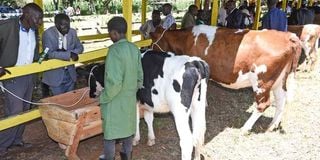Demystifying dairy cattle breeding and record-keeping

Cows at Eldoret University stand during the University of Eldoret Agribusiness Trade Fair on September 22, 2022. Recording of a pure breed is by the farmer and verified by experts.
The article on sourcing of pedigree in-calf heifers generated many questions directly to me and others on some of the farmers’ forums I belong to, phone and email.
There were three main themes in the inquiries. One was how records can be verified to be true and accurate.
Another group of farmers wondered if it is profitable to acquire cattle at very high prices and get the same amount of milk one would get from non-pedigree animals.
They argued that the animals eat the same amount of feed, require the same degree of care and possibly have the same length of a productive life as the non-pedigree but pure.
Lastly, there was the group that felt pedigrees are not for small-scale dairy farmers as the effort and cost of maintaining records for such animals can only be managed by large farms.
The good thing about the arguments was that they mainly emanated from personal experience or observation of fellow farmers. All the viewpoints are valid.
Pedigree is a breeding term that defines an animal’s known parentage over generations going back to at least the great-grandparents.
The record must be unbroken and traces the inheritance of a particular trait or traits that are considered superior to the breed or bloodline of animals when compared with others of the same breed.
The record must be written down, verified and approved by an independent official body.
A pure breed, on the other hand, is an animal that shows the conventional characteristics of the breed.
Animals showing purity indicators of 80 per cent and above may be considered to be pure. This is the case with most of Kenyan dairy breeds.
The recording of pure breeds is done by the farmer and verified by experts through physical examination.
From the foregoing, it is evident that a farmer may have pure dairy cattle that would qualify to have been pedigree if only the records had been properly maintained.
However, such animals can only be sold as pure but not pedigree.
Breeding for pedigree cattle requires meticulous record-keeping on the type of semen used, a high level of management of the animals and keeping of production records. This is because pedigree animals are considered to be of the highest quality in a breed.
They should, therefore, not only have records of breeding but also those of production performance especially output in milking, lactation period and lifelong production.
I, therefore, agreed with the farmers who insisted that pedigree production is unsuitable for small-scale farmers.
Like in every other business, the cost of production in dairy farming must always be much lower than the revenue generated.
A farmer with just a few cows should not involve herself in attempts to create pedigrees at her level.
I advise such farmers to go for pure cattle or mixed breeds and concentrate on producing milk and replacement stock for farmers of their category.
From my experience, dairy cattle suitable for small-scale farmers sell at Sh30,000 to Sh60,000, depending on body condition, stage of production, breed and economic pressure of the seller.
Milk revenue
The group that wondered if it is profitable to buy the high-priced pedigree animals only appeared to be considering milk revenue.
From research, farmers’ experience and business calculations, it is possible to make profits from milk revenue of pedigree dairy cattle.
But dairy farmers need to appreciate and target other revenue streams.
The additional revenue streams include the sale of high-value replacement stocks, bull calves and manure. The manure could also be used to grow its own fodder on the farm to bring down costs.
One very under-exploited dairy farming revenue stream is agro-tourism and peer training.
Any farm with good productive dairy cattle will always have enquiries for visits and training of farmers and workers.
Many farms provide these services at no fee or refuse to accept requests.
It would be advisable to convert the requests into business.
I finish with the group that wondered how pedigree records could be kept true and accurate.
I called members of the group the doubting Thomases because it is very difficult to fake pedigree records and get away unnoticed.
One said he was offered pedigree heifers on a farm.
When he visited the farm, he found it had more heifers than mothers.
The farmer should not have worried that he was being duped. He should have been happy that he was able, even without professional assistance, to realise the offer was fake.
Any serious farmer knows a cow should give a calf per year and the best ratio of heifers to bull calves is 50:50. A farm full of heifers and few mothers is cheating.
Locally, the author and custodian of dairy pedigree records are the Kenya Stud Book (KSB) which is managed by the Kenya Livestock Breeders’ Association (KLBA), Nakuru.
Those wishing to farm pedigree dairy cattle register with KLBA and provide records of their animals. KLBA inspectors visit the farm of the applicant and examine the animals for their physical conformance with the breed standard and breeding record.
KLBA Chief Executive, Leonard Mukhebi, says the organisation registers dairy cattle breeds to ensure farmers buy animals of the standard offered.
For cattle to be registered, they must attain the minimum standard of foundation grade. The subsequent grades, in order of purity, are intermediate, appendix and pedigree.
From the intermediate grade, animals must have their milk records registered with KSB.
With this diligence in dairy recording, it is unimaginable how pedigree records could possibly be falsified without detection.





